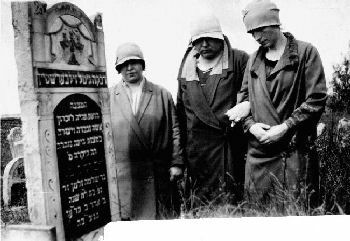Aninut
The first stage of
mourning is aninut, or "[intense] mourning." An onen
(a person in aninut) is considered to be in a state of
total shock and disorientation. Thus the onen is exempt
from performing mitzvot that require action (and attention),
such as praying and reciting blessings, wearing tefillin
(phylacteries), in order to be able to tend unhindered to the
funeral arrangements.
Aninut
lasts until the burial is over, or, if a mourner is unable to
attend the funeral, from the moment he is no longer involved
with the funeral itself.
Avelut
Aninut is
immediately followed by avelut ("mourning"). An avel
("mourner") does not listen to music or go to concerts, and does
not attend any joyous events or parties such as marriages or Bar
or Bat Mitzvahs, unless absolutely necessary. (If the date for
such an event has already been set prior to the death, it is
strictly forbidden for it to be postponed or canceled.)
Avelut
consists of three distinct periods.
Shiva – Seven days
The first stage of
avelut is shiva (Hebrew:
שבעה ;
"seven"), a week-long period of grief and mourning. Observance
of shiva is referred to by English-speaking Jews as
"sitting shiva". During this period, mourners
traditionally gather in one home and receive visitors.
It is
considered a great mitzvah
(commandment) of kindness and compassion to pay a home visit to
the mourners. Traditionally, no greetings are exchanged and
visitors wait for the mourners to initiate conversation. The
mourner is under no obligation to engage in conversation and
may, in fact, completely ignore his visitors.
There are various
customs as to what to say when taking leave of the mourner(s).
One of the most common is to say to them:
-
המקום ינחם אתכם בתוך
שאר אבלי ציון וירושלים
-
Hamakom
y'nachem etkhem b'tokh sha'ar avelei tziyon viyrushalayim:
-
"The Omnipresent
will comfort you (pl.) among the mourners of Zion and
Jerusalem."
Depending on their
community's customs, others may also add such wishes as: "You
should have no more tza'ar ('pain')" or "You should have
only simchas ('celebrations')" or "we should hear only
good news (besorot tovot) from each other" or "I wish you
long life".
Traditionally,
prayer services are organized in the house of mourning. It is
customary for the family to lead the services themselves.
Shloshim – Thirty
days
The thirty-day
period following the death (including shiva) is known as
shloshim (Hebrew:
שלושים ;
"thirty"). During shloshim, a mourner is forbidden to
marry or to attend a seudat mitzvah ("religious festive
meal"). Men do not shave or get haircuts during this time.
Since
Judaism teaches that a deceased person can still benefit from
the merit of mitzvot
(deeds commanded by God) done in their memory, it is considered
a special privilege to bring merit to the departed by learning
Torah in their name. A popular custom is to coordinate a group
of people who will jointly study the complete Mishnah during the
shloshim period.
Shneim asar chodesh
– Twelve months
Those mourning a
parent additionally observe a twelve-month period (Hebrew:
שנים עשר חודש,
shneim asar chodesh; "twelve
months"), counted from the day of death. During this period,
most activity returns to normal, although the mourners continue
to recite the mourner's kaddish as part of synagogue services
for eleven months, and there remain restrictions on attending
festive occasions and large gatherings, especially where live
music is played.






